
chapter 10
- Subject:
- World Cultures
- Material Type:
- Lecture Notes
- Author:
- Sandra Reynolds-Villalobos
- Date Added:
- 11/01/2021

chapter 10
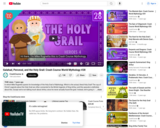
In which Mike Rugnetta quests for knowledge of the Holy Grail of Mythology. Which is the actual, literal Holy Grail! The cup of Christ! Legends about the Holy Grail are often connected to the British legends of King Arthur, and this episode is definitely about this. Except we’re not talking much about Arthur, since he never actually found the grail. Instead, we’re going to talk about a couple different versions of the Grail legend, the stories of Perceval and Galahad. So, sit back, relax, and enjoy learning Grail lore. You have chosen wisely!
This Lesson Plan was created by Joanna Pruitt as part of the 2020 ESU-NDE Remote Learning Plan Project. This original lesson is for classroom use; however, there is a virtual option as well. Educators worked with coaches to create Remote Learning Plans as a result of the COVID-19 pandemic. The attached Lesson Plan is designed for Grades 9-12 English Language Arts students; however, this could also be used as a Social Studies project as well. Students will evaluate credible sources through research on genocides post World War II after completing a novel unit covering the Holocaust. Students will also create scrapbooks using summarizing, citation, informative writing, textual evidence, caption writing, and persuasive writing. Students will also be expected to demonstrate oral communication skills as they have to present their projects to the class. Students will use background knowledge to clarify text and also gain a deeper understanding by using relevant evidence from a variety of sources to assist in analysis and reflection of informative text.

Students will work with simple Fairytale character vocabulary and descriptions of them (Prince--charming, Snowwhite-beautiful, etc.) preparing them to work next with more in-depth vocabulary in the form of a Fairytale infographic. The infographic contains several charts, descriptions and information pertaining to the top 10 most popular Gebrüder Grimm Fairytales for students to discover after preparing first with a pre-reading activity to front-load the vocabulary they will encounter in the infographic.
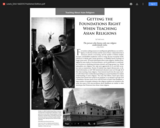
An article written by Todd Lewis that was published in Education About Asia in 2010 that discuses what educators need to know when they prepare to teach asian religions.
Introduction:
For teachers seeking resources to instill greater global literacy on world religions, it is the best of times and the worst of times. Cultural diversity in American schools is increasing, and the number of Hindu temples, mosques, and Buddhist meditation centers is rising. Because of popular media, references to Hindu gods, Daoist geomancy, or Buddhist karma teachings no longer seem exotic...

This lesson plan was created by Jennifer Pritchett as part of the 2020 Nebraska CTE-Beginning Teachers Institute. The attached lesson plan is designed for students in grades 7-12 as a introduction to a service learning project. This lesson plan can also be used in classes such as Sociology, Introduction to Education, Ethics, Leadership, etc. Students will learn the meanings of values and rank their top 5 values in a hands on or virtual format. The culminating project is collaboration on a Google Slides presentation with the rest of the class.
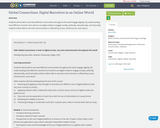
Students will be able to see how different communities throughout the world engage digitally. By understanding how different countries and cultures use digital media to engage socially, politically, educationally, and financially students will be able to see how communication is affected by access, infrastructure, and culture.
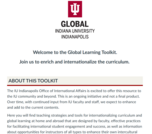
The Global Learning Toolkit, an online resource for faculty and staff anywhere in the world to incorporate that global perspective into every classroom was created by the Indiana University Indianapolis Office of International Affairs, and includes content developed across ten contributing IU schools, the Multicultural Center, and Office of International Affairs staff. The project was made possible in part by the UISFL grant.

This kit provides the materials and background information needed to engage students in a dynamic and constructive process of learning how global media perspectives differ based on country of production, media source, target audience, and political and social context. There are five lessons representing important issues and media documents from: Africa (news and documentary film clips about the food crisis), Latin America (editorial cartoons about immigration), Europe (news and documentary film clips about Islam and cultural identity), India (magazine covers about India's rise in the global economy), and Southeast Asia (websites concerning Islamic majorities and minorities).

This lesson will have students analyze connections among historical events and developments in the contemporary global issue of trade, specifically, trade between the United States and China. Students will answer the compelling question; Do tariffs improve the lives of workers in a country and in an industry?Students will research the history of trade, specifically, the silk road. How did this trade route affect the lives of ordinary people? How does the relationship over time between the United States and China affect trade? Students will create a similar learning experience building a lesson that connects the historical events and developments to a contemporary issue around globalization. Copy of the Lesson in a Google Doc. Licensed with a Creative Commons Attribution License.

The world is becoming more and more interconnected. Globalization changes how people consume, work and live almost everywhere on the world. Today, many economic, political, cultural or ecological relationships are not explainable from a national perspective. At the same time, a controversial debate about the consequences of globalization has begun. But what are the main causes for globalization? In what areas it is most prominent? And who are the winners and looser of globalization?

In this story, Jangmi moves from her home in Korea to a new home in the United States. At first she is sad about leaving behind her friends and Korean customs and traditions, but once she arrives in America she begins to adjust. She becomes hopeful that someday America could feel like home, too.

Resource suggestions to explore and consider as a way to support learning in grades 6-8 World Languages.

Resource suggestions to explore and consider as a way to support learning in grades 9-12 World Languages.
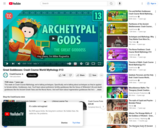
This week on Crash Course Mythology, we're talking archetypes. Specifically, we're talking about archetypes as they're applied to female deities. Goddesses, man. You'll learn about prehistoric fertility goddesses like the Venus of Willendorf, life and death goddesses like the Ancient Greek Fates and the Norse Norns. And we'll learn about regeneration goddesses like Ireland's Nimah, and Japan's Oto-Hime.

"Over Time: Discover The Great Pyramids of Giza Through the Ages" by Google Arts & Culture is a successive series of slides that depict the Great Pyramids and The Great Sphinx of Giza over a period of 100+ years. Captions for each image help the viewer infer archeological significance of the site. The exploration tool at the end enables the viewer to take a closer look around.The printable scavenger hunt encourages students to slow down and focus on the main points of each caption. They will record information on the printout.
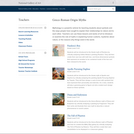
Mythology is a powerful vehicle for teaching students about symbols and the ways people have sought to explain their relationships to nature and to each other. Teachers can use these lessons and works of art to introduce or examine the role of myths in explaining human customs, mysteries about nature, or the reasons why things exist in the world. Lessons include: Pandora's Box; Apollo Pursuing Daphne; Diana and Endymion; The Fall of Phaeton; and The Corinthian Maid.
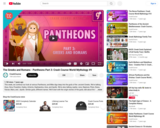
This week, we continue our look at various Pantheons, and Mike digs deep into the gods of the ancient Greeks. We're talking Zeus, Hera, Poseidon, Hades, Artemis, Hephaestos, Ares, and Apollo. We're also talking Jupiter, Juno, Neptune, Pluto, Diana, Vulcan, Mars, and...Apollo. Similar gods, different names. We'll start with the origin stories of the gods, talk about their family relationships, and what exactly their specialties are.
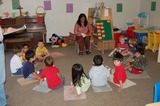
Five-day unit plan that leverages the power of the Classroom Circle to teach classroom expectations, recognizing values, self-awareness, emotions, strengths and struggles, teamwork, and empathy. The Classroom Circle is a powerful tool in building a classroom community. It's a way to teach and practice expectations for speaking and listening, as well as creating a classroom that provides a safe place for students to be vulnerable, empathetic, and to build on their own self-awareness.

There is a presentation about one of the wonderful cities of Turkey. It includes most important sides of the city and it is supported with good landscapes of the city. You can get very useful information about this good city and you can use this resource for reading activity. Please help your students to translate the text :)